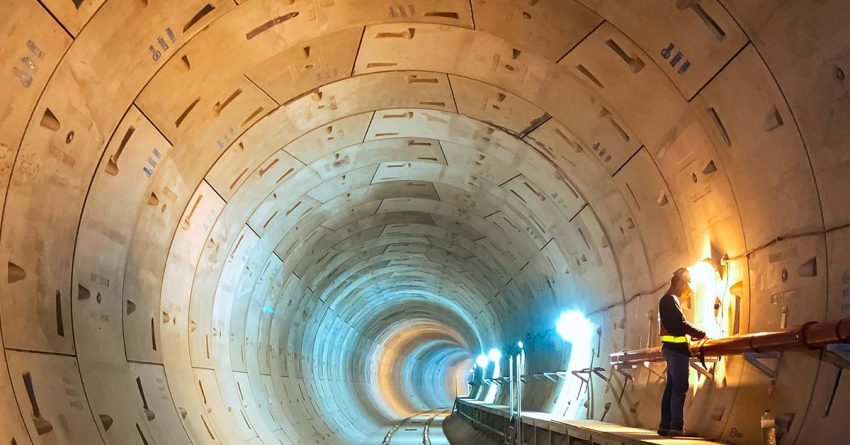Imagine living in a world where traveling across the Atlantic Ocean was as easy as catching a train to get to work instead of flying. This fantastical vision serves as the basis for a proposed transatlantic tunnel, which is a massive engineering project that would connect the United States of America with the United Kingdom, thereby reducing the amount of time it takes to travel between the two countries to less than an hour. The bold human spirit to transcend geographical bounds and strengthen worldwide ties is exemplified by this endeavor, which is predicted to cost around twenty trillion dollars, or fifteen and a half trillion pounds worth.
The Eternal Hope of Constructing a Tunnel Across the Atlantic Ocean

Despite the fact that the concept may appear to be cutting edge, it is not new. An undersea tube that extends beneath the huge length of the Atlantic Ocean has been a concept that has been around for more than a century. In comparison, the Channel Tunnel, which spans 23.5 miles and connects England and France, is a far smaller endeavor than this one. Unlike the Transatlantic Tunnel, which would cover about 3,400 miles and descend many miles below the surface of the ocean, the Channel Tunnel required six years of laborious work to be completed.
Amazing feats of engineering: theoretical approaches to the tunnel and its construction

There are a number of different approaches that engineers and visionaries have come up with in order to make this ambitious tunnel a reality. It has been suggested that a pathway may be built beneath the ocean floor, a conduit could be suspended above it, or a hybrid model could be utilized. The concept of a floating tube that is submerged 49 meters below the surface is yet another creative conception. In order to strike a balance between the enormous pressure of the ocean depths and the dangers of surface marine activity, this structure would be made up of prefabricated segments that would have tension cables that would hold them in place.
High-Speed Travel: A Revolutionary Step Forward for the Transportation Industry

In order to support high-speed train travel, the primary role of the Transatlantic Tunnel would be to perform. Because the trip would take several days and require a complicated infrastructure to support drivers, traditional car travel would not be a realistic option. Instead, the trains that are being planned, which are considered to be vactrains, have the potential to move at astounding speeds of up to 5,000 miles per hour.
Only fifty-four minutes would be required to go from London to New York City if this were to take place. Research has also been conducted on other ideas, such as jet propulsion. Additionally, trains that are propelled by jet engines are capable of reaching comparable speeds; however, in order to ensure that they arrive at their destinations safely, they would need to decelerate for a period of eighteen minutes.
Problems with the Economy and Logistical Operations

The Transatlantic Tunnel has been firmly placed in the realm of speculation due to the huge expenses and practical obstacles that are linked with it. It is more accurate to say that the initiative is still a theoretical exercise rather than a practical plan because governments are not currently considering any actual ideas.
There are further underwater tunnels in the horizon.

Comparable ideas for underwater infrastructure are gaining traction in other parts of the world, even though the Transatlantic Tunnel may still remain a pipe dream. The projected tunnel that would stretch over the Strait of Gibraltar and connect Spain and Morocco is a noteworthy example of this.
The Connection Between Europe and Africa: A Workable Alternative Situation

Through the Strait of Gibraltar tunnel, which would connect Punta Paloma in Spain with Malabata in Morocco, it would be possible to span the gap between Europe and Africa. Compared to the Transatlantic Tunnel, this project would be a shorter and less intimidating venture because it would involve a length of water that is 17 miles long and would descend to a depth of 475 meters.
In contrast to the hypothetical project that would include crossing the Atlantic Ocean, the designs for the Gibraltar tunnel are further along. A feasibility study is currently being carried out by the Moroccan National Company for Strait Studies (SNED) in order to assess the difficulties that are associated with the financial and logistical matters. The project, which is considered to be an essential strategic link for both continents, is estimated to cost six billion pounds and will include a third maintenance tunnel.
A Future That Exceeds People’s Capabilities

Humanity’s unbounded drive to create and connect is exemplified by the Transatlantic Tunnel. Its idea drives breakthroughs in engineering and fosters global discussions about the possibilities of these kinds of infrastructure, despite the fact that its construction may appear to be out of reach. We can use initiatives that are smaller but just as impactful, like as the Gibraltar tunnel, as a stepping stone on the path to achieving these lofty goals until that time comes.
